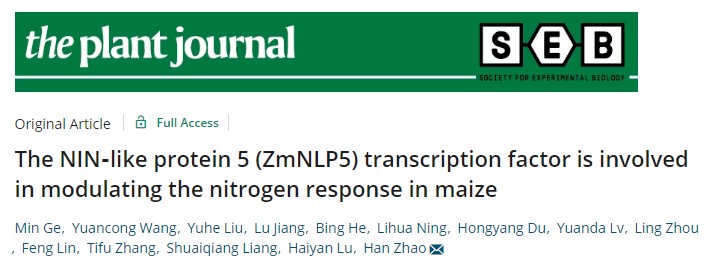Recently, the research team leading by Prof. Han Zhao from the Institute of Germplasm Resources and Biotechnology, JAAS, published an article entitled "The NIN-like protein 5 (ZmNLP5) transcription factor is involved in modulating the nitrogen response in maize" in “The Plant Journal”. The study reported that the NIN-like protein 5 (ZmNLP5), a transcription factor, plays an important role in modulating early N response in maize.

Nitrogen (N) is an essential nutrient for plant growth and development. It also acts as a signal molecule in coordinating the expression of genes associated with nitrogen metabolism pathways. Plants have evolved sophisticated mechanisms to cope with the fluctuation of external N. Understanding the mechanism underlying N response in maize can provide a theoretical basis for improving the N use efficiency (NUE), which is crucial for improving the productivity of N-based fertilizer.
NIN-like protein (NLP) is a plant-specific transcription factor (TF) family. NLP family members, in many cases, are important regulatory elements for modulating plant nitrogen response and are often involved in regulating plant nitrogen metabolism. However, the functions of these TFs in maize are rarely reported. In the study, the authors used the DeGN co-expression network analysis and found a node gene, namely ZmNLP5, as a central hub gene in a molecular network associated with N metabolism. Predominantly expressed and accumulated in roots and vascular tissues, ZmNLP5 was shown to rapidly respond to nitrate treatment. Under limited N supply, compared with that of wild-type (WT) seedlings, the zmnlp5 mutant seedlings accumulated less nitrate and nitrite in the root tissues and ammonium in the shoot tissues. For the mature plants, the zmnlp5 mutants accumulated less nitrogen than the wild type (WT) plants in the ear leaves and seed kernels. Furthermore, the mutants carrying the transgenic ZmNLP5 cDNA fragment significantly increased the nitrate content in the root tissues compared with that of the zmnlp5 mutants. In the zmnlp5 mutant plants, loss of the ZmNLP5 function led to changes in expression for a significant number of genes involved in N signaling and metabolism. The authors further show that ZmNLP5 directly regulates the expression of nitrite reductase 1.1 (ZmNIR1.1) by binding to the nitrate-responsive cis-element (NRE) at the 5′ UTR of the gene. Interestingly, a natural loss-of-function allele of ZmNLP5 in Mo17 conferred less N accumulation in the ear leaves and seed kernels resembling that of the zmnlp5 mutant plants. These findings show that ZmNLP5 is involved in mediating the plant response to N in maize.
This study suggests that ZmNLP5 can improve the nitrogen assimilation and utilization in maize through binding and activating the expression of key genes in the nitrogen assimilation pathway. This improvement is more obvious when the plants were grown under the condition of nitrogen limitation, indicating that ZmNLP5 has the potential value of improving maize NUE and reducing N loss in the soil, providing new insights for enhancing efficient nitrogen breeding in maize.
The paper was authored by Ge Min and Dr. Wang Yuancong. Prof. Han Zhao is the corresponding author of the paper. This work was supported by the National Key Research and Development Program of China, the National Natural Science Foundation of China, the Natural Science Foundation of Jiangsu Province, China, and the Institute Foundation of Jiangsu Academy of Agricultural Sciences.
The full article is available on the Plant Journal website at https://onlinelibrary.wiley.com/doi/10.1111/tpj.14628.


